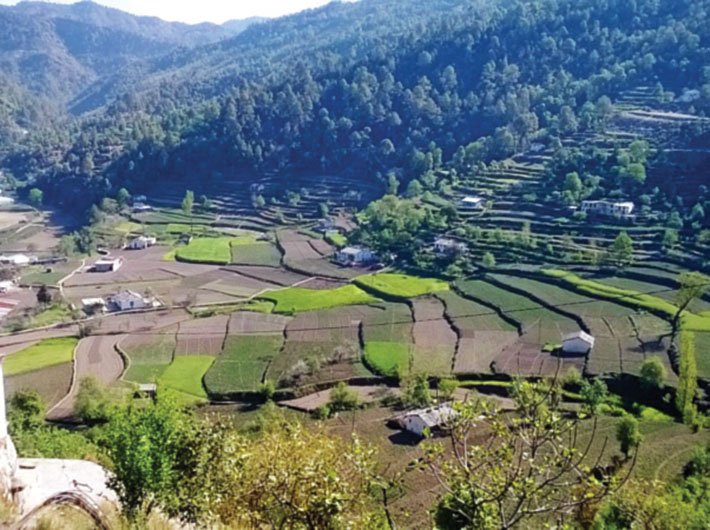With lifestyle of people drastically changing in the last few decades, wide and nutritious variety of traditional regional crops seems to be vanishing from the central Himalayan food basket
A young army man returning home on annual leave or relatives coming over to celebrate the festival of the family deity; this is almost an archetypal scene from a village home in the remote central Himalayan State of Uttarakhand. The visitors would sit on the Kitchen floor, which is freshly painted with a mixture of cow-dung and clay obtained from a nearby creek. They would invariably eat from a bronze plate; food would mostly comprise boiled red rice mixed with chulkani (spicy soup of black soya bean) and badi (cooked gravy of dried lumps of pulses mixed with grated cucumber) and a spoonful of hot and tangy chutney made from sour pomegranate seeds and curd. A tumblerful of buttermilk is put in front of the guest’s plate and raita - made of grated yellow cucumber and seasoned thick curd - served as a perfect accompaniment to the delicious food.
The scene is straight out of many a short story written in the late 1960s and 1970s by prominent Hindi writers from the hills, like Shekhar Joshi, Shivani, Panu Kholia, Shailesh Matiyani. One would invariably come across a ‘fauzi’ son who is home for his vacation or guests being fed these food in the hillside homes of hillfolks. In fact, baked breads of finger millet (madua), foxtail millet (jhangora) boiled with red rice, sorrels, tubers, roots, fruits and leaves of the naturally growing vegetation were essential and unique features of a typical central Himalayan platter. However, in the last four decades, the colour and content of this age-old platter have undergone a drastic change. This has in fact pushed the traditional food and culinary tastes of the hill people in to the oblivion.
From time immemorial, people in central Himalayan regions of Kumaon and Garhwal hills had a well established tradition of subsistence agriculture. Plenty of crops grew so easily and the local would make them into savouries and delicious foods, which, in turn, became part of their identity. Dr IS Bisht, senior scientist, National Bureau of Plant Genetic Resources, New Delhi, recalls his growing up in the hills. He says that the landrace crops were so full of diversity that the sole grocery the hill people would have to buy was jaggery and common salt.
Growing crops however, was no easy task though with over 80 percent of the land being rain fed, small and fragmented land holdings were difficult to till and vagaries of weather posed a challenge to the human grit. Yet the locals were able to keep their granaries full of stocks and barely anyone suffered from malnutrition. There was plenty of food for everyone and all the time of the year.
The key crops growing in the hills comprised millets, barley, amaranth, mustard, sesame, and a wide range of beans and pulses. Wheat and rice, cultivated generally in the river valleys, had a large number of acclimatized landraces. In his book ‘The Himalayan Gazetteer’ T E Aitknson, speaks of over a thousand genomes of rice alone, in the past century and a half that grew in these hills. Millets, a staple food then – with low carbohydrates and several times higher amount (nearly 300 percent) of trace elements, minerals, antioxidants and even proteins – were far more nutritious than wheat and rice. The stalks and other leftover of these crops after harvest was great fodder and in sufficient quantity for a large number of cattle (mostly goats), which, in turn would ensure supply of good proteins to the farmers. Grown over the year in isolation of other influences, these indigenous varieties were fully pest and drought resistant and didn’t need synthetic fertilisers.
Also their cultivation didn’t require a large manpower. The locals had also developed an innovative strategy of growing mixed and multiple crops. They would use direct seeded rice (DSR) method to grow paddy and on the margins of it’s field, they would sow millets. Peas were grown with wheat and radish. Parsnip, kidney beans and Amaranth happened to be the natural companions of maize. Baranaza kheti (sowing twelve seeds together), common in those days, was kind of an insurance against crop failure. In addition to this, backyard farming of seasonal vegetables, tubers and spices and the naturally growing foods collected from the village outskirts played a crucial role in making the diet of the hill folks rich and wholesome. This remarkable system had emerged in the total absence of road network and market economy. The hunger and malnutrition were alien words here as their way of life guaranteed them the round-the-year availability of wholesome and nutritious diet.
In the past 30-40 years, the food basket of the region, has lost its vibrancy and colours too. What the dieticians in today’s world prefer to call a rainbow diet had been a way of life for the prople of the hills. With changes in the name of development and modernity effecting them too, quite a few colours have been lost from this charming rainbow basket. Women going for education and professions and migration of menfolk to cities for jobs and opportunities has cut down a family’s labour force. Rapid urbanisation, especially the mushrooming of summer retreats and hideouts of affluent elites from cities in the inner hills, has resulted in sale of agriculture land. The farmers are too tired of living a life of basic subsistence they don’t mind selling the land for a one-time hefty price. They have no idea of the long term repercussions of this on their lives.
Since the late 1990s, the cultivable area in Uttarakhand has been shrinking - 15 to 20 percent per year. In the upcoming foothill towns this figure has already gone beyond 50 percent. As such in the hilly terrains, generally only about seven percent of the land is cultivation worthy.
Ironically, institutions like the GB Pant University of Agriculture and Technology, Pantnagar, and Vivekananda Parvatiya Krishi Anusandhan Sansthan (a unit of Indian Council of Agricultural Research), Almora, are also promoting cultivation of cash crops - mainly off-season vegetables- for the urban markets, pushing the idea of subsistence farming to the back burner. However, a few small villages like Kumati, a two-century-old habitation below the Mukteshwar-Almora road, is perhaps one of the last bastions of crop diversity in the region. With the heavily subsidised poly houses being so available, majority of the hill villages are finding cultivation of the off-season vegetable and flowers for the consumption of urban markets a lucrative proposition. The off-season cabbage, cauliflower, broccoli, capsicum, and flowers like gerbera, lilies, etc have indeed jacked up income of the villagers. However, the money earned is being spent on consumer goods and not on nutritious diet, which once grew in abundance and has since disappeared. A yawning gap between dietary needs and affordability coupled with a blasé attitude towards healthy food often directs the villagers to buy foodstuff from the nearby market. They buy foods produced in unregistered local bakeries, stale vegetables, sweetmeats, sugary syrups, localised versions of Chinese food cooked in the most unhygienic conditions and mutton sold in open without any safeguards. A large sum of inflowing cash through the sale of land and commercial cultivation is generally squandered in social abuses like gambling and alcoholism. The advent of a new global food culture has created new myths and misconceptions about food. Now, consumption of millets and uncultivated food items is considered quite derogatory. Yet another stigma attached to the finger and foxtail millet is the belief that their consumption make one’s skin darker. Even on festive occasions, the villagers now do not cook traditional millets and happily serve chowmein and momos to the guests.
Interestingly, pulses and millets grown in the hills have of late become a rage with the nutrition obsessed city population. The same millets which once grew in abundance in the hill are now available in cities, albeit at exorbitant rates. The health conscious people in the cities alone can afford them. The villages, who had once lived off these, are now heavily dependent on the substandard rice-wheat grains made available through public distribution system. The cheap and subsidised PDS staple is also one of the reason for people giving up cultivation of traditional crops in hills. However, to be fair to the farmers, they had been troubled by an army of monkeys, wild boars and ungulates for nearly 20 years, who would invade and destroy their standing crops. The administration didn’t do anything to help them that time.
These changes have naturally resulted in new health issues in the region. A few decades ago, skin diseases (due to lack of personal hygiene), worm infestation, tuberculosis and goiter (in pockets with iodine deficiency) were the common ailments in the area. Nobody had even heard of diseases like diabetes, anaemia, cardiovascular ailments, osteoporosis, blood pressure - caused by deficiency of vital elements inside the human body. Research done in different pockets of the hills have shown that regular consumption of millets and other wild foods was mainly responsible for this resistance. Today no wonder diseases like osteoporosis, anaemia, arthritis, gallstone, etc. are widespread among women and cases of diabetes and cardiovascular ailments, ophthalmic and pulmonary disorders can easily be found among the youth.
Have the people of hills paid a price for getting assimilated into a modern world?
(This article has been written as part of CSE Media Fellowship)
feedback@governancenow.com
(The article appears in the February 1-15, 2016 issue)

